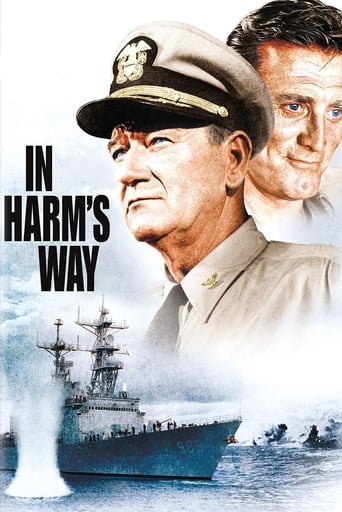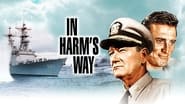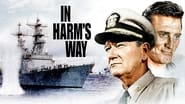inspectors71
which makes Otto Preminger's In Harm's Way even better. I've loved IHW for over four decades, mainly because of the straightforward, solid, and emotionally satisfying storytelling. I'll leave the synopsis of the movie to the other writers. Here, I just want to say thank you to all involved with this visually beautiful, patriotic morality tale of naval warfare in the Pacific Theater of World War II. There's something very satisfying with the combination of military history, political intrigue, love, lust-for-power, and Preminger's elegant use of black and white film. Bring aboard John Wayne at his most pensive and introspective, Kirk Douglas at his most dashing and tortured, Patricia Neal projecting a middle-aged sexiness that I couldn't even begin to appreciate the first time I saw IHW (1972), and a slew of great, great secondary performances, and the viewer may begin to get a little short of breath. How does one movie have so much going for it, and nobody's ever heard of it?Side note: It flopped at the box office. Oh, well.Even Jerry Goldsmith, a composer best known for Patton, gives IHW's score a richness that compliments the dreamy, creamy, and colorful cinematography. There are so many reasons to love In Harm's Way that a fan can and should forgive its many flaws. There are technical quibbles sprinkled throughout the film that make a nitpicker like me cringe, then shrug. And the most glaring flaw in the movie is the use of large models for the climactic sea battle between a Japanese force and Wayne's numerically inferior battle group. Critics have panned the whole movie for the non-CGI phoniness of the battle.The critics are wrong. Even Wayne and Douglas, who fought against the inclusion of the battle with Preminger, to know avail, were wrong. The battle gives In Harm's Way an "old school" feel, beyond the B&W and the fact that most of the actors and actresses and crew have passed on. In Harm's Way is my favorite war movie. Soap suds and slickeries and idiosyncrasies--and all those exploding car-length warships-- can't take away the fact that this is a very satisfying, well-acted, and grown- up story.
vincentlynch-moonoi
Problem # 1 has to do with budget. If they didn't tell you the air attack early on in the film was the bombing of Pearl Harbor, you'd hardly know it. Seemed very minor according to this film. But, of course, no special effects of note back then, so the attack on Pearl Harbor seems like a slight unpleasantness.Problem # 2: Now, I don't know how it was, but about 8 weeks after the devastating attack on Pearl Harbor it seems as if everything in Honolulu was back to normal and the military was partying it up. Is that really the way it was? I doubt it, but again, I don't know. But then, there's not another bomb or even firecracker that goes off for well over an hour. Kinda sparse action for a war movie Problem # 3: Filmed in 1965 and still black and white. Again, must be budget. Filmed in Hawaii and region, it would have been a beautiful film in color.Problem # 4: It took me a long time to figure out this one. The film takes place in the 1940s, but it feels too much like the 1960s. Oh, they have all the right automobiles and such, but the music seems There are other elements of this movie that balance things out and make it a very good film. Chief among these is the cast: John Wayne, Kirk Douglas, Patricia Neal, Burgess Meredith, Tom Tryon, Dana Andrews, Franchot Tone, Carroll O'Connor, Henry Fonda, and many more, all with varying levels of roles, some rather short, but all key in some way.Of course, the main character here is John Wayne, who was beginning to look kinda old here. Wayne made one of my favorite films the same year -- "The Sons Of Katie Elder". Wayne here plays John Wayne. Which is fine.Kirk Douglas plays a personal ne'er do well, but a competent junior officer to John Wayne (who, BTW, is promoted to admiral during the film). I'm not sure you can be both, but Douglas is always Douglas.Patricia Neal does very nicely as John Wayne's love interest.Dana Andrews has a strong role as a not-so-effective vice-admiral. He's excellent! Burgess Meredith has a part that is different from his typical. Very good performance.So now it's time to get down to the nitty gritty, and this is it: I rarely like war movies. My father was in the military, and almost every time he would come home on leave, he would drag me to the theater to watch a war movie. I loved having time with him, but HATED war movies. Even though I love old movies, it is extremely rare for me to watch a war movie. BUT -- I enjoyed this movie despite its shortcomings. It's a long movie, and it fully held my attention.Recommended.
rmrgmm
Jery Goldsmith's score certainly deserves great credit for boosting this film's status in spite of its flaws primarily in such simple matters as editing, continuity, factual blunders, and shadows of filming equipment showing up in a number of places. Of particular note in the Goldsmith score is the very compelling "San Francisco" theme music (a name I give for the sake of this commentary) as Paula Prentiss is seen grabbing a trolley car to meet "Mac" two-thirds of the way into the film. The french horn passage incorporated into that as Tom Tryon disembarks from the hospital ship is a crowning glory - a great set piece of film music!
Robert J. Maxwell
James Bassett's novel was pretty retrograde for the mid 1960s. It endorsed every apple-pie value imaginable. Adulterers and rapists die. The Navy was good, but politicians, high-class Bostonian elites, public relations personnel, journalists, and rear echelon headline mongerers were condemned. On top of that the book was clumsily written. Everyone -- men and women alike -- seemed to speak with the same cadence and vocabulary. Cliché followed cliché. When -- Full speed ahead; damn the spoilers! -- when Rockwell Torrey loses a leg at the end of the story, he's ashamed to face his girl friend because he's "only half a man." I'm not making that up. And when, on the eve of battle, an officer confesses that he's scared to death, Wayne admits that he too is scared. We've seen that identical exchange dozens of times. In this case Wayne's deportment didn't convince me he was really scared. He seemed strung out behind 3 milligrams of Xanax.The novel could have been written with Hollywood in mind because it has all the audience appeal of any other commercial effort -- three (or maybe four) romantic relationships going on at once, bureaucratic intrigue with heroes and villains, and an opening sea battle and an even bigger climactic engagement.Wendell Mayes, the screenwriter, pulls all these threads together in a way that, while still leaving this a mediocre effort, improves on the book, if only by shortening it.John Wayne exudes relaxed authority, which is his forte. He could have walked through the part but he does a thoroughly professional job. Kirk Douglas is second in the credits but has a much smaller part as Wayne's competent but tormented assistant. Both men were aging visibly by this time in their careers and at times it seems that Douglas is wearing a Kirk Douglas mask, but Douglas at least gets the few humorous moments in the story.Brandon De Wilde was splendid as the little boy in "Shane" eleven years earlier, and fine as the naive teen in "Hud." Here, as a Wayne's estranged son, a young Harvard-educated PT boat officer, he's adequate but no more than that.Patricia Neal is Wayne's girl friend, a savvy but gentle nurse. She's no longer a glamorous kid either, but her face seems careworn and soft. She's a suitable mate for Wayne. Jill Haworth is the saucy young nurse who is engaged to De Wilde but tempts Douglas beyond the point of redemption. She's more figure than talent. There's a third romance between the heroic Tom Tryon and the achingly horny Paula Prentiss, but it's not clear why this narrative thread was left in the script. The intrigues and their dynamics are dazzling enough without it.The battles were done with models, as was usual at the time, and the special effects are okay for the period, but compare the contemporary "Sink the Bismarck" to see how it could have been more convincingly executed. That last engagement was a bit confusing because when ships are exploding, it's hard to tell one from another.Historically the whole affair is fiction. Well -- two real figures appear on the screen. Admiral Husband Kimmel (Franchot Tone) who got all the blame for the naval disaster at Pearl Harbor and whose head rolled, and Admiral Nimitz (Henry Fonda) who has two or three short scenes of no particular distinction.The climactic battle steals elements from Guadalcanal (if we don't stop the Japanese from finishing that airstrip, we're sunk), Surigao Strait (the Japanese are caught by mines and torpedo boats in a narrow channel during a night action), and Leyte Gulf (a super battleship and numerous escorts against a lesser fleet of American ships, with the Japanese turned away at the last minute by a display of American gallantry). Nice black-and-white photography.It's not a bad movie but rather strictly routine. There are no stand out performances because there are no opportunities for stand out performances. The script is too bland for that. Preminger does manage one actually shocking incident. It takes place in the officer's john, and involves Douglas slapping the evil-looking Patrick O'Neal several times across the face -- hard. Otherwise, it's by the numbers.







